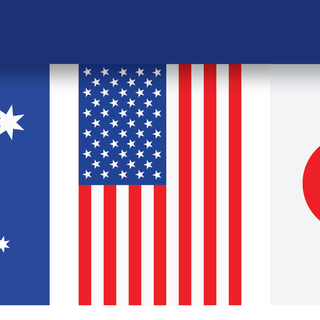We’ve seen action by global leaders to make supply chains more resilient and secure technologies critical to national interests, such as US banning high-end chip fabrication technology exports to China and negotiating agreements with Japan and Netherlands.
We have also watched as issues around Chinese technology abound, from TikTok user data being accessible in China to Huawei bans.
Even in the last week, we’ve found more than 900 Chinese-made security cameras in Australian government buildings, while the United States has shot down Chinese ‘spy’ balloons.
However, until now, we haven’t had much idea what Australians, Americans and the Japanese really think about trust and distrust in technology and the potential for ‘decoupling’.
The United States Studies Centre (USSC) conducted a public opinion survey in late 2022 in the United States, Australia and Japan, to understand the public sentiment in each nation on a variety of issues.
Our polling data shows public sentiment is concerned that Chinese technology poses a threat to national security.
This previously unreleased polling data reveals the depth of concern about Chinese technology among Australian, American, and Japanese populations, and across multiple data points. It also shows support for stable or even increased national restrictions on Chinese technology and deep distrust and concern about Chinese mobile devices.
Australian government official and defence buildings have this month been found to have Chinese surveillance cameras which are banned in the United States and the United Kingdom.
Our polling data shows public sentiment is concerned that Chinese technology poses a threat to national security. All three publics agreed that existing restrictions on Chinese firms should either continue (32–38 per cent across countries) or increase (37–42 per cent) — including those firms supplying telecommunications products and developing future tech such as quantum and artificial intelligence. Less than 10 per cent in any country wanted restrictions decreased.
Collaboration with trusted allies and distrust in Chinese technology: American, Australian and Japanese views on technology

Overwhelming levels of public support for broadening technology collaboration amongst allies, especially the United States, Australia and Japan are therefore unsurprising. The vast majority (70 per cent or more) of respondents in the United States, Australia and Japan want to see greater collaboration with allies on issues around climate change and emerging technologies like artificial intelligence, quantum computers and semiconductor manufacturing.
If we want to unleash this trilateral enthusiasm for collaboration, public-private partnerships will be key, with much of the expertise and scale necessary for this work — developing advanced capabilities and emerging technologies — coming from industry.
In a geopolitical sense, ‘the Indo-Pacific region is defined increasingly by a multipolarity.’ In technology adoption, the choices are starker.
Supply chains are global in nature meaning that alignment of views among allies is important as seen by the US-Japan-Netherlands agreement on semiconductor export controls.
Nevertheless, most technologies are designed, manufactured, and/or updated by either the United States or China, from individual mobile phone handsets to national telecommunications infrastructure and weapons systems.
Decoupling digital innovation, technology and data flows seen to be critical to national security is one thing, but individual user choice preferencing US technology adds a different dimension to the conversation.
Decoupling digital innovation, technology and data flows seen to be critical to national security is one thing, but individual user choice preferencing US technology adds a different dimension to the conversation.
Across multiple data points, this polling data shows that respondents from all countries are concerned with technology coming from China and prefer US technology. A slight majority of Australian voters indicated they do not trust or mostly do not trust technology from China.
Japanese respondents were the most distrusting of Chinese technology (83 per cent), followed by the US (68 per cent) and Australia (54 per cent). Across all three countries, there was a correlation between age and trust, with older citizens (65 and older) placing less trust in Chinese technology.
It is difficult to separate stated intention and action but even so, these figures are startling. They show a slim majority of voters from all age groups and countries polled are not at all willing to download Chinese apps.
In contrast, a vast majority of Australian voters indicated they fully or mostly trust technology from the United States with a small but still sizeable number of respondents (20 per cent) indicating they mostly or fully do not trust tech from the United States.
In this vein, USSC polling data shows a remarkable number of respondents from Australia, as well as the United States and Japan, are willing to pay more for technology not from China. As my colleagues Jared Mondschein and Victoria Cooper recently revealed, more than 70 per cent of Americans and Australians would pay $500 more for a phone not made in China.
This polling shows concern from an individual user perspective, with a willingness to pay more for smartphone technology not made in China, lower levels of trust in Chinese technology compared to American technology, and lower willingness to download Chinese applications compared to US-owned applications. Whilst it is hard to know how many of these stated intentions will translate to action, it nevertheless shows a clear individual preference for technology with a trusted lineage.
What we are likely to see is an increase in difficult national security conversations around trusted — and distrusted — technology as well as increasing user demand for technologies that keep their data safe, are created by trusted entities, are able to be regulated, and have safeguards exist to mitigate harm.
Whilst governments discuss the viability of decoupling technologies, perhaps users are making the decision for them. Technology distrust is, in fact, the real decoupling issue we face today.







